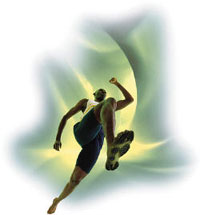Sports technology in the Olympics
[ 2006-10-25 16:53 ]
在古代,奥运选手都是凭借肌肉力量、体力和速度去赢得令人垂涎的橄榄枝编织而成的桂冠。正如顾拜旦所说,两千年以来人们都在庆祝这种“运动信仰”。但是,自顾拜旦开始对体育进行研究从而促使他组织一种全新的奥运之后的一百年里,奥运会始终都与运动、科学相结合,将科研、技术和运动融为一体,使每四年一次的体育盛会提升到了令人无法想象的高度。

In ancient times Olympic athletes relied on raw
strength, sinew and speed to earn a coveted olive wreath. For two millennia they
celebrated the "religion of sport", as French educator Pierre de Coubertin put
it.
In the hundred years since Baron de Coubertin's studies of physical
exercise led him to marshal a new Olympic Movement, the Games have increasingly
embraced the science of sport. This is a union of research, technology and
athletics that has elevated the quadrennial festival to unimagined
heights.
Throughout the modern Olympic Games, technology has been a
partner with pageantry and prowess. Two of the first three Olympiads were
relegated exhibition status as part of the World's Fair, a showplace for new
technology and science. By 1912, Olympic athletes benefited from electronic
timing, while spectators got their first taste of public-address
systems.
High-speed film for assessing performance debuted in 1928, and
both radio and television were still experimental when first used in the Games.
In 1964, satellites broadcasted the Olympics worldwide, and the international
audience reached 1 billion eight years later.
From microchips on marathon
runner's shoes to ultrasensitive touch pads in the pool, there's a 007 trove of
gadgetry behind the Games to help separate the Olympic medal-winners from the
also-rans.
One of the freestyle relay swimmers in Swiss swimming team was
proved by an equipment to have jumped off the starting block a tenth of a second
before his teammate touched the wall. Swimming touch pads were first used in
competition at the 1987 Commonwealth Games in Brisbane, Australia. Sensors
embedded inside the starting block record when a swimmer leaves, and an
ultrathin plastic touch pad on the wall under the water can calculate within
hundredths of a second when the swimmer lands. The touch pads are specially
ridged to ensure the swimmer's fingertip, not the force of the water the swimmer
is displacing, trips the sensor. Cameras that take 100 pictures a second, aimed
on the touch pads and starting blocks, back up the touch system.
The
cameras used in track and field are the most sensitive. The extremely fast
cameras, which take 1000 images per second, shoot only the first 8 millimeters
of the finish line. As the runners cross, the cameras capture their bodies in a
series of thousands of minuscule bits, first photographing the tips of the toe,
then the finger then the tips of the nose, with resolution so fine it can pick
up the hair on runners' bodies. All those thousands of pictures are then
electronically pieced together to reproduce a photo finish. That's why the
runners' bodies look distorted in official finish line recordings, because the
picture is not an actual picture but a visual recreation of matter crossing a
point in time. The same technology is used in rowing, flat water canoe and
kayaking, and cycling events.
When marathon runners traced the historic
steps of Philippides from the coastal city of Marathon to the 1896 Olympic
stadium, they had microchips tied to the laces of their distance and
speed.
Bicyclists use a transponder clipped to a spoke on their front
wheel to record their finish time. It sends signals from the bike to antennae
along the route so judges can confirm who is in first.
(Foreign and Domestic Olympic Stories
)
|